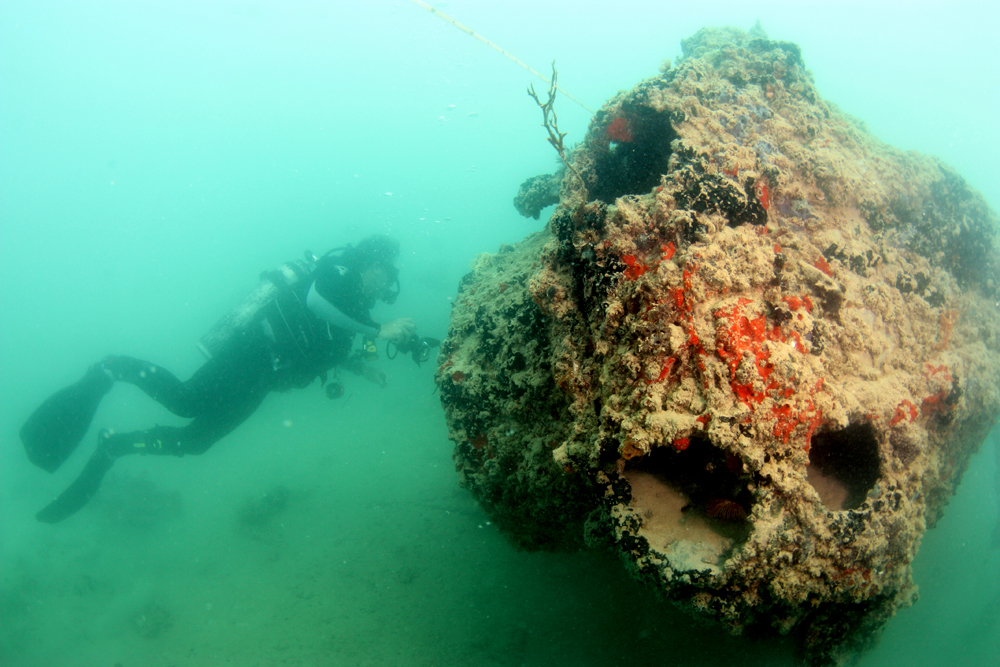74 Years Later, Sunken Pearl Harbor Plane Still Filled with Mystery

A ghostly, sea-life-encrusted airplane that has been resting at the bottom of Oahu's Kāne‛ohe Bay for three-quarters of a century was recently photographed underwater by archaeologists in Hawaii.
The U.S. Navy plane, a Catalina PBY-5 "flying boat," went down during the first few minutes of the Japanese attack on Pearl Harbor on Dec. 7, 1941. Just before bombing the Pearl Harbor naval base, Japanese planes dropped bombs on the nearby Naval Air Station on the east coast of Oahu. The recently photographed plane was one of 27 Catalina PBY planes to be destroyed in that preliminary attack.
Archaeologists and history enthusiasts have tried to get decent pictures of the drowned plane for decades. In 1994, a dive team attempted to photograph the wreck, but the murky waters of Kāne‛ohe Bay thwarted their efforts. More recently, in 2008, the sport diving group Hawaii Underwater Explorers tried to take pictures of the plane, but their efforts also failed because of the bay's cloudy waters. [Lost in Pearl Harbor: WWII-Era Navy Plane Finally Photographed]
But in June, a team of students from the University of Hawaii were finally able to take clear images of the wreck. The group also performed a comprehensive archaeological survey of the sunken plane and its surroundings with help from Hans Van Tilburg, a maritime archaeologist with the National Oceanic and Atmospheric Administration (NOAA).
The archaeologists found that the plane sits in three pieces on the floor of Kāne‛ohe Bay, at a depth of about 30 feet (9 meters).
"The new images and site plan help tell the story of a largely forgotten casualty of the attack," Van Tilburg said in a statement. "The sunken PBY plane is a very important reminder of the 'Day of Infamy,' just like the USS Arizona and USS Utah. They are all direct casualties of [Dec.] 7."
The identity of the aircraft and its crewmembers remains unknown, Van Tilburg said, adding that it's possible that the plane was destroyed while crewmembers tried to take off during the attack.
Sign up for the Live Science daily newsletter now
Get the world’s most fascinating discoveries delivered straight to your inbox.
The USS Arizona and the USS Utah were two of five U.S. battleships that sunk during the Pearl Harbor bombings. More than 2,000 Americans were killed in the attack that sparked the United States' entry into World War II. The loss of the Catalina "flying boats" during the bombing was a significant one for the U.S. military, because without these long-range bombers, American pilots couldn't pursue the enemy or engage in an immediate retaliation against Japanese aircraft carriers stationed nearby on the day of the attack.
Only 11 Catalina PBYs survived the attack unscathed, and these bombers did track the Japanese fleet, though this action didn't lead to a counterattack, according to the Pacific Aviation Museum on Oahu.
But now, one of these waterlogged bombers provides "a window into the events of the attack," said June Cleghorn, a senior archaeologist at Marine Corps Base Hawaii. The new pictures of the "flying boat" could reveal more about how the planes and crewmembers from the Naval Air Station on Oahu were lost during the infamous attack, she added.
It's unlikely that archaeologists will ever know precisely what happened to the decades-old plane, especially because they aren't allowed to move it. The wreck is protected by the Sunken Military Craft Act of 2004, which prohibits the disturbance of sunken military vessels owned by the U.S. or foreign vessels that lie in U.S. waters.
Follow Elizabeth Palermo @techEpalermo. Follow Live Science @livescience, Facebook & Google+. Original article on Live Science.

Elizabeth is a former Live Science associate editor and current director of audience development at the Chamber of Commerce. She graduated with a bachelor of arts degree from George Washington University. Elizabeth has traveled throughout the Americas, studying political systems and indigenous cultures and teaching English to students of all ages.










